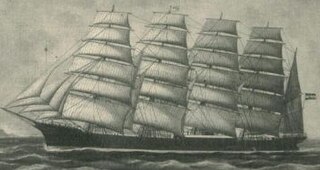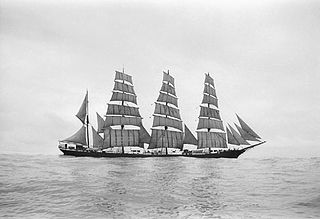
The Flying P-Liners were the sailing ships of the German shipping company F. Laeisz of Hamburg.

Pamir was a four-masted barque built for the German shipping company F. Laeisz. One of their famous Flying P-Liners, she was the last commercial sailing ship to round Cape Horn, in 1949. By 1957, she had been outmoded by modern bulk carriers and could not operate at a profit. Her shipping consortium's inability to finance much-needed repairs or to recruit sufficient sail-trained officers caused severe technical difficulties. On 21 September 1957, she was caught in Hurricane Carrie and sank off the Azores, with only six survivors rescued after an extensive search.

The Chilean Civil War of 1891 was a civil war in Chile fought between forces supporting Congress and forces supporting the President, José Manuel Balmaceda from 16 January 1891 to 18 September 1891. The war saw a confrontation between the Chilean Army and the Chilean Navy, siding with the president and the congress, respectively. This conflict ended with the defeat of the Chilean Army and the presidential forces and President Balmaceda committing suicide as a consequence. In Chilean historiography the war marks the end of the Liberal Republic and the beginning of the Parliamentary Era.

Marco Polo was a three-masted wooden clipper ship, launched in 1851 at Saint John, New Brunswick. She was named after Venetian traveler Marco Polo. The ship carried emigrants and passengers to Australia and was the first vessel to make the round trip from Liverpool in under six months. Later in her career, the ship was used as a cargo ship before running aground off Cavendish, Prince Edward Island, in 1883.

Passat is a German four-masted steel barque and one of the Flying P-Liners, the famous sailing ships of the German shipping company F. Laeisz. She is one of the last surviving windjammers.

Peking is a steel-hulled four-masted barque. A so-called Flying P-Liner of the German company F. Laeisz, it was one of the last generation of cargo-carrying iron-hulled sailing ships used in the nitrate trade and wheat trade around Cape Horn.

Preussen (PROY-sin) was a German steel-hulled, five-masted, ship-rigged sailing ship built in 1902 for the F. Laeisz shipping company and named after the German state and kingdom of Prussia. It was the world's only ship of this class with five masts, carrying six square sails on each mast.

Potosi was a five-masted steel barque built in 1895 by Joh. C. Tecklenborg ship yard in Geestemünde, Germany, for the sailing ship company F. Laeisz as a trading vessel. Its primary purpose was as a "nitrate clipper" collecting guano in South America for use in chemical companies in Germany. As its shipping route was between Germany and Chile, it was designed to be capable of withstanding the rough weather encountered around Cape Horn.

Placilla was a four-masted barque which was built for F. Laeisz, Hamburg, Germany in 1892. She was sold in 1901 and renamed Optima in 1903. In 1905 she was wrecked on the Haisborough Sands.

Parma was a four-masted steel-hulled barque which was built in 1902 as Arrow for the Anglo-American Oil Co Ltd, London. In 1912 she was sold to F. Laeisz, Hamburg, Germany. During the First World War she was interned in Chile, and postwar was assigned to the United Kingdom as war reparations. She was sold back to Laiesz in 1921. She was sold in 1931 to Ruben De Cloux & Alan Villiers of Mariehamn, Finland. Following an accident in 1936, she was sold and hulked at Haifa, British Mandate of Palestine, now Israel, for two years before being scrapped.

Ponape was a four-masted steel–hulled barque which was built in 1903 in Italy as Regina Elena for an Italian owner. In 1911 she was sold to Germany and renamed Ponape. In 1914 she was arrested by HMS Majestic and confiscated as a war prize by the Admiralty. She was renamed Bellhouse In 1915 she was sold to Norwegian owners. In 1925, she was sold to Finland and again named Ponape serving until she was scrapped in 1936.

Priwall was a four-masted steel-hulled barque with royal sails over double top and topgallant sails. The windjammer was ordered by the F. Laeisz shipping company of Hamburg and launched at the Blohm & Voss yard, Hamburg, on 23 June 1917. After delays arising from a shortage of materials during and after First World War, she was completed on 6 March 1920. Priwall was used on the nitrate trade route to the west coast of South America; she also made several voyages from South Australia’s Spencer Gulf grain ports to Europe. Her code Letters were RWLN; in 1934 they were changed to DIRQ.

Omega was a four-masted, steel-hulled barque built in Greenock, Scotland in 1887. In 1957 Omega became the last working cargo-carrying square-rigger afloat. She carried oil, guano, nitrate, wheat, and other goods. She sank in 1958, ending that age of sail.

Esmeralda was a wooden-hulled steam corvette of the Chilean Navy, launched in 1855, and sunk by the Peruvian ironclad Huáscar on 21 May 1879 at the Battle of Iquique during the War of the Pacific.

Cimba was a British-built clipper in the Australian wool trade. She sailed between London and Sydney for 20 years, from 1878 to 1898. In 1905, Cimba set the sailing ship record for a passage from Callao to Iquique, of 14 days.

Adolf Vinnen was a five-masted barquentine that was built by Friedrich Krupp Germaniawerft, Kiel, Germany. She was wrecked on her maiden voyage in 1923.

Rodney was an iron-hulled clipper ship that was built in Sunderland in 1874 and wrecked on the Cornish coast in 1901. She was one of the last ships built for the Australian migration trade. Devitt and Moore operated her between Britain and Australia for more than two decades. Rodney set numerous records for speed, and had luxuries that were unusual for her era.

SS Oceana was a P&O passenger liner and cargo vessel, launched in 1887 by Harland and Wolff of Belfast and completed in 1888. Originally assigned to carry passengers and mail between London and Australia, she was later assigned to routes between London and British India. On 16 March 1912 the ship collided in the Strait of Dover with the Pisagua, a 2,850 GRT German-registered four-masted steel-hulled barque. As a result Oceana sank off Beachy Head on the East Sussex coast, with the loss of 17 lives.

Birkdale, a steel, steam-powered barque, is best known for being the inspiration behind many paintings by John Everett. Everett joined the barque Birkdale in 1920 and on a short voyage drew and painted many drawings and paintings, most of which are hung in the National Maritime Museum at Greenwich. She was the last barque to fly the red ensign, and she spent almost all her working life carrying nitrate from Chile. In June 1927, Birkdale ran aground and wrecked after catching fire in the Nelson Strait while en route to Peru.

The Raids of the Huáscar were a series of raids that occurred by the Peruvian ironclad Huáscar under the command of Miguel Grau Seminario during the War of the Pacific. The actions kept the Chilean government in check for nearly five months which ended after the Battle of Angamos.




















